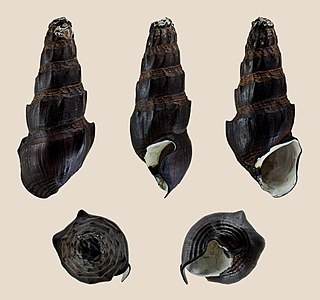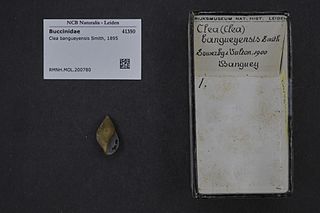Beddomeia camensis is a species of very small freshwater snail that is endemic to Australia. The invertebrate is 2-4 mm in size, it is a gastropod mollusk and belongs to the Hydrobiidae family, a large family of freshwater snails recognised by their small size and cosmopolitan distribution. Beddomeia camensis is one of the least populated species within its family distributed across only 5 small to medium-sized streams that flow into the Cam River catchment in North-West Tasmania.

Madagasikara spinosa is a species of tropical freshwater snail with a gill and an operculum, an aquatic gastropod mollusc in the family Pachychilidae.

Anentome helena, common name assassin snail or bumblebee snail, is a species of freshwater snail with an operculum, an aquatic gastropod in the family Nassariidae, most of which are marine.

Clea is a genus of freshwater snails with opercula, aquatic gastropod mollusks in the subfamily Anentominae of the family Nassariidae, a family, almost all of the rest of which are marine.

Freshwater snails are gastropod mollusks that live in fresh water. There are many different families. They are found throughout the world in various habitats, ranging from ephemeral pools to the largest lakes, and from small seeps and springs to major rivers. The great majority of freshwater gastropods have a shell, with very few exceptions. Some groups of snails that live in freshwater respire using gills, whereas other groups need to reach the surface to breathe air. In addition, some are amphibious and have both gills and a lung. Most feed on algae, but many are detritivores and some are filter feeders.
Enneapterygius clea, or Clea's triplefin, is a species of threefin blenny in the genus Enneapterygius, described by German ichthyologist Ronald Fricke in 1997. It is endemic to Queensland, Australia.

Clea bangueyensis is a species of freshwater snail with an operculum, an aquatic gastropod mollusk in the family Buccinidae, the true whelks, most of which are marine.

Clea bockii is a species of freshwater snail with an operculum, an aquatic gastropod mollusk in the family Buccinidae, the true whelks, most of which are marine.
Clea broti is a Southeast Asian species of freshwater snail with an operculum, an aquatic gastropod mollusk in the family Buccinidae, the true whelks, most of which are marine.

Clea cambojiensis is a species of freshwater snail with an operculum, an aquatic gastropod mollusk in the family Buccinidae, the true whelks, most of which are marine.
Clea fusca is a species of freshwater snail with an operculum, an aquatic gastropod mollusk in the family Buccinidae, the true whelks, most of which are marine.

Clea hidalgoi is a Southeast Asian species of freshwater snail with an operculum, an aquatic gastropod mollusk in the family Nassariidae, most of which are marine.
Clea jullieni is a Southeast Asian species of freshwater snail with an operculum, an aquatic gastropod mollusk in the family Buccinidae, the true whelks, most of which are marine.

Clea nigricans is a species of freshwater snail with an operculum, an aquatic gastropod mollusk in the family Buccinidae, the true whelks, most of which are marine.
Clea paviei is a Southeast Asian species of freshwater snail with an operculum, an aquatic gastropod mollusk in the family Buccinidae, the true whelks, most of which are marine.
Clea scalarina is a Southeast Asian species of freshwater snail with an operculum, an aquatic gastropod mollusk in the family Buccinidae, the true whelks, most of which are marine.
Clea wykoffi is a species of freshwater snail with an operculum, an aquatic gastropod mollusk in the family Buccinidae, the true whelks, most of which are marine.
Laevapex fuscus, the dusky ancylid, is a species of small, freshwater, air-breathing limpet, an aquatic pulmonate gastropod mollusc or micromollusc in the family Planorbidae, the ram's horn snails and their allies.
Floridobia is a genus of very small freshwater snails that have an operculum, in the family Hydrobiidae, the mud snails.

Anentome is a genus of freshwater snails with opercula, aquatic gastropod mollusks in the subfamily Anentominae of the family Nassariidae, a family, almost all of the rest of which are marine.









